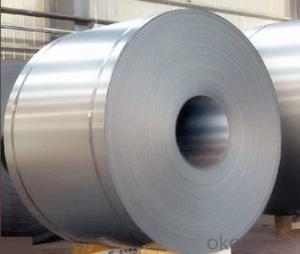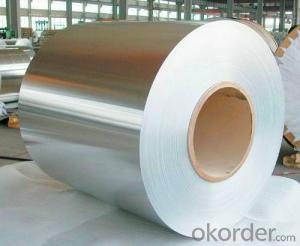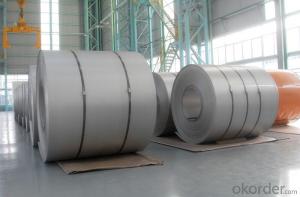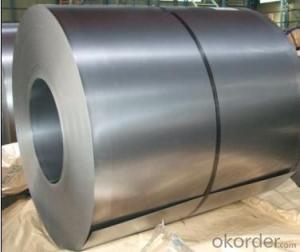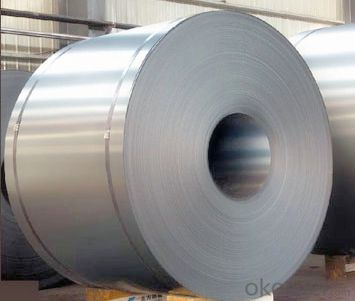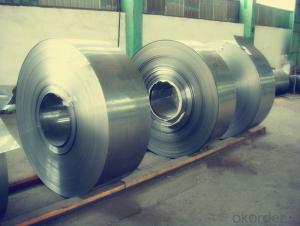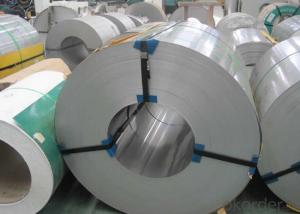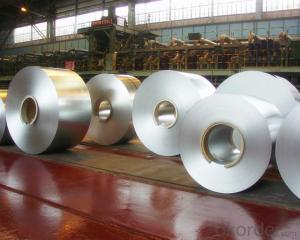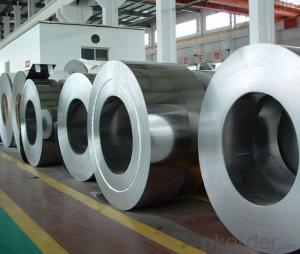Stainless Steel Coil 201 Hot / Cold Rolled
- Loading Port:
- Lianyungang
- Payment Terms:
- TT OR LC
- Min Order Qty:
- 400 m.t.
- Supply Capability:
- 5000 m.t./month
OKorder Service Pledge
OKorder Financial Service
You Might Also Like
201 Hot Rolled Stainless Steel Coil Specifications
THK:2.3/2.5/3.0/4.0mm
Width:485/510/550/610/1010/1240mm
Face:No.1
201 Hot rolled stainless steel Coil Application
Stainless steel is a production which not easy rust,acid resistance and corrosion resistance,so it is widely
used in light industry,heavy industry,daily necessities and the decoration industry.
201 hot rolled stainless steel coil, use to produce cold rolled stainless steel coil and stainless steel tube, pipe.
201 Hot Stainless Steel Coil Chemical Composition(WT%)
(C):≤0.15, (Si):≤0.75, (Mn):5.5~7.50, (Cr):16.0~18.0, (N):≤0.25, (Ni):3.50~5.50, (P):≤0.060, (S):≤0.030
201 Hot Rolled Stainless Steel Coil
Strength Of Extension:100,000 To 180,000 Psi;
Yield Strength:50,000 To 150,000 Psi
Elongation :55 To 60%;
Modulus Of Elasticity:29,000,000 Psi;
Density :.280lbs/Cubic Inch(7.93g/Cm3)
- Q: Are stainless steel strips suitable for dairy tanks?
- Yes, stainless steel strips are suitable for dairy tanks. Stainless steel is a popular choice for dairy tanks due to its excellent corrosion resistance, hygienic properties, and ease of cleaning. It is also resistant to bacterial growth and does not react with milk or other dairy products, making it a safe and reliable material for dairy tank construction.
- Q: Are stainless steel strips suitable for outdoor signage?
- Yes, stainless steel strips are suitable for outdoor signage. Stainless steel is highly resistant to corrosion, making it ideal for outdoor applications where durability is essential. It can withstand exposure to various weather conditions, including rain, snow, and UV rays, without deteriorating or losing its aesthetic appeal. Additionally, stainless steel strips provide a sleek and modern look that can enhance the visual impact of outdoor signage.
- Q: How do stainless steel strips resist embrittlement in high-temperature applications?
- Stainless steel strips are known for their exceptional resistance to embrittlement in high-temperature applications. This resistance is primarily attributed to the unique composition and microstructure of stainless steel. Stainless steel is an alloy that contains a significant amount of chromium, typically ranging from 10-30%. The presence of chromium in stainless steel plays a crucial role in its resistance to embrittlement. Chromium forms a passive oxide layer on the surface of stainless steel, known as chromium oxide or Cr2O3. This oxide layer acts as a protective barrier, preventing the diffusion of harmful elements and reducing the susceptibility to embrittlement. In high-temperature environments, stainless steel strips retain their resistance to embrittlement due to the stability of the chromium oxide layer. This layer remains intact even at elevated temperatures, providing a continuous barrier against the corrosive and embrittling effects of the surrounding environment. Furthermore, stainless steel also contains other alloying elements such as nickel and molybdenum, which contribute to its high-temperature strength and resistance to embrittlement. These elements enhance the stability of the microstructure, preventing the formation of brittle phases and maintaining the ductility of the stainless steel strips. The fine-grained microstructure of stainless steel is another key factor in its resistance to embrittlement. The fine grains inhibit the propagation of cracks and reduce the overall susceptibility to fracture, even at high temperatures. Additionally, the presence of carbides, nitrides, or other precipitates within the stainless steel matrix can help to pin dislocations and prevent their movement, further enhancing the resistance to embrittlement. Overall, stainless steel strips resist embrittlement in high-temperature applications due to the protective chromium oxide layer, the presence of alloying elements, the stability of the microstructure, and the inhibiting effects of precipitates. These factors combine to ensure that stainless steel maintains its strength, ductility, and resistance to fracture, even under extreme temperature conditions.
- Q: How do stainless steel strips resist pitting?
- Stainless steel strips resist pitting due to the presence of chromium in the alloy, which forms a passive oxide layer on the surface. This oxide layer acts as a protective barrier, preventing the penetration of corrosive agents and thus reducing the risk of pitting corrosion.
- Q: Can 111 stainless steel strips be etched or engraved for customization?
- Indeed, customization is possible for 111 stainless steel strips through etching or engraving. Stainless steel, being a versatile material, lends itself well to these processes, which can be achieved using different techniques like chemical etching, laser engraving, or mechanical engraving. By employing these methods, the stainless steel strips can be customized with utmost precision and intricate details, thereby offering limitless options for personalization or branding objectives. To achieve the desired outcome and identify the most appropriate technique for the specific customization requirements, it is advisable to seek guidance from a professional engraver or etcher.
- Q: How does the thermal conductivity of 111 stainless steel strips compare to other materials?
- Compared to other materials, the thermal conductivity of 111 stainless steel strips is generally lower. When compared to metals like copper or aluminum, stainless steel is not an efficient conductor of heat. However, among the stainless steel family, the 111 grade may exhibit slightly higher thermal conductivity than other grades. Nevertheless, it remains lower than many commonly used materials. For applications that demand high thermal conductivity, materials like copper or aluminum, which possess superior thermal conductivity properties, would be more appropriate.
- Q: Are 111 stainless steel strips susceptible to stress corrosion cracking?
- Stainless steel strips containing 111 as their crystallographic orientation can indeed be susceptible to stress corrosion cracking (SCC). However, it is important to note that SCC is influenced by various factors including the specific environment, applied stress levels, and the material's microstructure and composition. While 111-oriented stainless steel strips may exhibit higher resistance to SCC compared to some other crystallographic orientations, they are not completely immune to this type of corrosion. SCC occurs when a combination of tensile stress and a corrosive environment exists, leading to cracking of the material. The susceptibility of 111 stainless steel strips to SCC can be influenced by the presence of certain corrosive agents such as chloride ions or hydrogen sulfide. These agents can penetrate the passive oxide layer on the stainless steel surface, leading to the initiation and propagation of cracks under applied stress. To mitigate the risk of stress corrosion cracking in stainless steel strips, several measures can be taken. These include selecting a stainless steel grade with improved SCC resistance, avoiding exposure to corrosive environments, controlling applied stress levels, and implementing appropriate surface treatments or coatings. Additionally, regular inspection and maintenance can help detect any potential signs of SCC and prevent further damage. In summary, while 111 stainless steel strips may have some resistance to stress corrosion cracking, their susceptibility to this type of corrosion depends on multiple factors. Taking appropriate preventive measures and understanding the specific environment in which the material is used are essential for minimizing the risk of SCC.
- Q: Can stainless steel strips be bent or folded without cracking?
- Stainless steel strips possess the ability to be bent or folded without experiencing any cracking. The exceptional ductility and formability of stainless steel allow for effortless manipulation into diverse shapes without sustaining any fractures. However, it is crucial to consider the recommended bend radius, which pertains to the tightness of the bend, in order to prevent any potential damage or cracking to the material. Furthermore, the bendability of the stainless steel strip can also be influenced by its type and thickness, with thinner strips generally exhibiting greater flexibility. In summary, if appropriate techniques and parameters are adhered to, stainless steel strips can be subjected to bending or folding processes without encountering any cracking.
- Q: What is the toughness of stainless steel strips?
- Stainless steel strips are known for their high toughness, making them resistant to cracking, fractures, and deformation even under extreme conditions.
- Q: What is the hardness of stainless steel band 3/4?
- 304 stainless steel is the United States materials and Testing Association (ASTM) named SUS 304 stainless steel brand abbreviation. 304 stainless steel, 1Cr18Ni9., is a widely used austenitic stainless steel.
Send your message to us
Stainless Steel Coil 201 Hot / Cold Rolled
- Loading Port:
- Lianyungang
- Payment Terms:
- TT OR LC
- Min Order Qty:
- 400 m.t.
- Supply Capability:
- 5000 m.t./month
OKorder Service Pledge
OKorder Financial Service
Similar products
Hot products
Hot Searches
Related keywords
